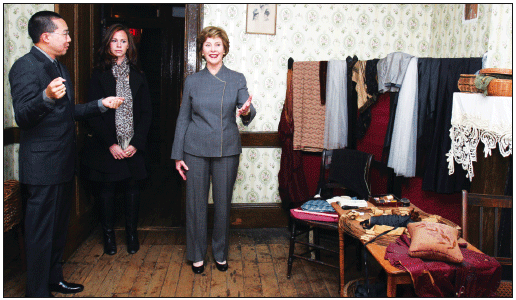By Lincoln Anderson
It was a far cry from their sprawling ranch in Crawford, as First Lady Laura Bush and daughter Barbara Bush got a private tour of the Lower East Side Tenement Museum last Friday. The first lady was in town to present the Preserve America History Teacher Award and, as a big fan of museums, decided to pay the historic Orchard St. building a visit.
A contingent of suit-wearing Secret Service agents, squiggly communication wires dangling from their ears, were posted throughout the cramped building on every floor, as David Eng, its vice president of public relations, guided the Bushes up the slightly rickety stairs, past walls and ceilings with peeling paint and through each carefully restored apartment.
Reporters and photographers were instructed to stand behind a roped-off area in one apartment and not wander about the building as the tour proceeded. They were then instructed to repeat the procedure in another apartment one floor up. The first lady and first daughter didn’t take questions from the press, seemingly intent on enjoying their private session with Eng.
“This is a really good way for Americans to see what immigration is in our history,” Laura Bush said appreciatively at one point, noting she had long wanted to visit the museum.
Eng explained various details of the apartments and their former occupants. In the apartment of the Gumpertz family, he noted that for an hour of gas for the lights, tenants used to have to put a quarter in a meter; one night in 1874, Julius, the family’s father, never returned, and was eventually ruled a homicide victim, Eng said.
They also saw the re-created apartment of the Rogarshevskys, whose father, Abraham, died of “tailor’s disease,” as tuberculosis was known. Mirrors were covered and round-shaped foods were set on the table depicting the scene when the family sat shiva for him, Eng explained. Abraham’s wife, Fannie, was 97 Orchard St.’s last tenant. Listed as the building’s “janitress,” she lived there until 1941, when she moved into a nearby housing project, Eng said.
“Interesting,” the first lady remarked to him as they turned to visit another of the museum’s rooms. “You’ve interpreted it in such an interesting way.”


































